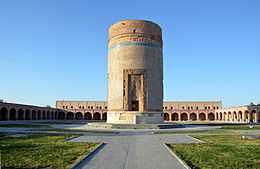Shaykh Haydar
| Part of a series on Shia Islam |
| Twelver Shi'ism |
|---|
|
|

Shaykh Haydar or Sheikh Haydar (Template:Lang-fa Shaikh Ḥaidar) was the successor of his father (Shaykh Junayd) as leader of the Safaviyya from 1460-1488. Haydar maintained the policies and political ambitions initiated by his father. Under Sheikh Haydar, the Safaviyya became crystallized as a political movement with an increasingly extremist heterodox Twelver Shi'i coloring and Haydar was viewed as a divine figure by his followers.[1] Shaykh Haydar was responsible for instructing his followers to adopt the scarlet headgear of 12 gores commemorating The Twelve Imams, which led to them being designated by the Turkish term Qizilbash "Red Head".[2]
History
In 1469-70, Haydar was installed in Ardabil by his uncle Uzun Hassan, who had defeated Jahan Shah of Kara Koyunlu dynasty at the Battle of Chapakchur and established his own authority over its former domains. The Safaviyya return to Ardabil prompted an influx of Haydar’s followers from northern Syria and eastern Anatolia to Ardabil to be beside him.[3] Soon after, in 1471-1472, Haydar married Uzun Hassan’s daughter Halima, daughter of Despina Khatun, daughter of John IV of Trebizond).[4][5] This marriage produced three sons: Sultan Ali Safawi, Ibrahim Mirza and Ismail I.[6]
Probably knowing that his forces were not strong enough to try conclusions with the Aq Qoyunlu, Haydar let his forces on a razzia against the "infidels" of Circassia and Dagestan. This involved crossing the territory of the Shirvanshahs.
In the following year (1488), he was defeated and killed in Derbent by the combined forces of the Shirvanshah ruler Farrukh Yassar and the Ak Koyunlu Sultan Ya'qub ibn Uzun Hassan, during one of his military expeditions while trying to avenge his father's death, and was succeeded by his son Sultan Ali Safawi as the leader of the Safaviyya.
Following his death, his tomb in Ardabil became a place of pilgrimage.
Succession
See also
Notes
- ^ Islam without Allah?, By Colin Turner, pg.63
- ^ The Ismāʻı̄lı̄s, By Farhad Daftary, pg.466
- ^ Islam without Allah?, By Colin Turner, pg.63
- ^ Safavid Iran, By Andrew J. Newman, pg.129
- ^ Don Juan of Persia - A Shi-Ah Catholic 1560-1604, By & Brothers Harper & Brothers, Harper Brothers Staff, &. Brothers Harper &. Brothers, pg.107
- ^ Voices of Islam: Voices of tradition, By Vincent J. Cornell, pg.225
